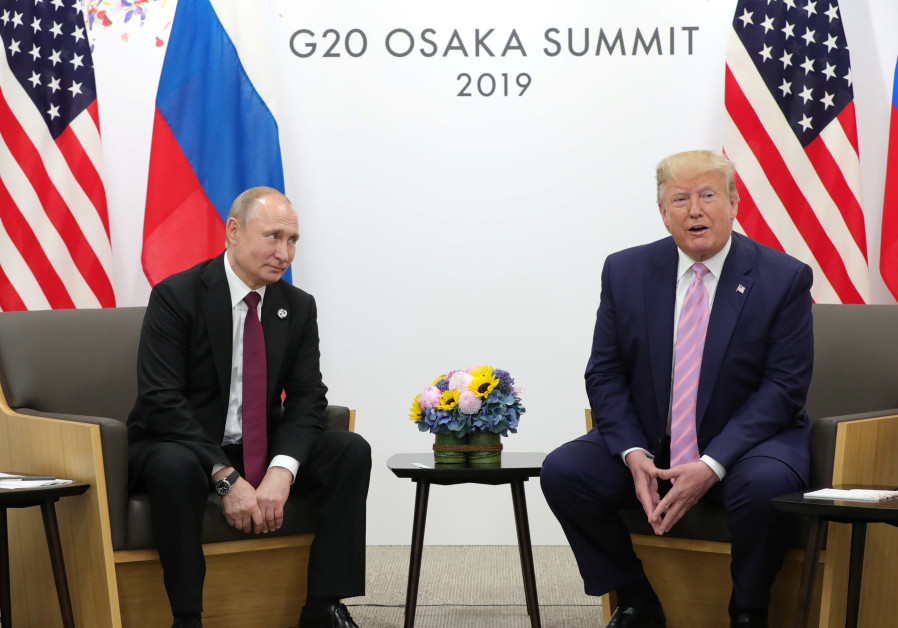
The threat posed by a potential nuclear Iran is no laughing matter.
But neither is the escalating threat of a nuclear exchange between the US and Russia.
They are collectively in the process of ending their mutual nuclear restrictions and developing new, more advanced nuclear weapons which could be used against each other.
As things stand, the US last week formally exited the 1987 Intermediate-Range Nuclear Forces (INF) treaty which had eliminated around 2,700 US and Soviet nuclear weapons on the European continent, and may exit the new Strategic Arms Reduction Treaty (START) in 2021.
START, which replaced older nuclear treaties between the countries that have been running for decades, had limited the US and Russia Since 2010 to 700 deployed missiles and bombers, 1,550 deployed warheads and 800 deployed and non-deployed launchers.
Following exiting the INF, America is expected to test a ground-launched cruise missile in the coming weeks. And in November, the Pentagon plans to test an intermediate-range ballistic missile.
Both would technically be tests of conventional, not nuclear weapons.
But the 1987 INF pact banned such ground-launched nuclear and conventional ground-launched ballistic and cruise missiles with ranges of 310 to 3,400 miles (500-5,500 km.) – weapons developments in the conventional arena can pave the way to developments in the nuclear arena.
Two security problems have motivated the US to turn on the arms-control treaty process, which had been viewed as highly successful for decades.
Despite its initial success, a dispute over Russian compliance had festered since 2014, when the US first publicly accused Russia of violating the INF.
US anger at Russia worsened in 2017 when Moscow began deploying a ground-launched cruise missile, the 9M729, capable of traveling in the treaty’s prohibited 500-5,500 kilometer range.
For well over a year, the administration of President Donald Trump tried to coax Russia back into compliance until October 2018 when Trump abruptly moved toward exiting the deal, which finally occurred formally last week.
Russia was not the only reason that the US turned sour on the treaty.
Last week, new US Defense Secretary Mark Esper said he supported placing ground-launched, intermediate-range missiles in Asia relatively soon.
US OFF7ICIALS have been warning for years that America was at an increasing disadvantage relative to China’s development of increasingly sophisticated land-based missile forces.
Until now, the Pentagon could not match China with ground-based missile forces due to the INF treaty with Russia.
Critics of the Trump administration said that the US could continue to rely on other capabilities as a counterbalance to China, like missiles fired from US naval vessels or aircraft.
However, advocates for a US land-based missile response had argued that the best way to deter Chinese use of its muscular land-based missile forces was to mirror the capability by leaving the INF deal.
Moscow has signaled that if Washington increases its nuclear forces, it may increase the number of the 9M729 ground-launched cruise missiles on mobile launchers, as well as its Kaliber sea-based cruise missile system.
A variety of measures were previously passed and are now being debated in Congress to fund research and development of the next generation of US nuclear and conventional ballistic weapons, with sums reaching around $100 million.
Critics say that Russia and China were developing some of these capabilities to offset the obvious, overall broad US military advantages that they will never be able to fully counter.
They also say that the around $100 million price tag is just the beginning of what could be billions of dollars wasted and a new, modern arms race which could run out of control.
All of this also connects back to Iran.
While at some point in history, the US and Russia might have thought that their uniquely destructive nuclear and cyber abilities would remain between them, recent history has disproved this.
The number of countries with nuclear weapons continually grew from two to nine and is threatening to grow further.
In addition, if a country like North Korea can develop what is believed to be the beginnings of a hydrogen nuclear bomb (leaving behind the early generation atomic bomb), then other new nuclear and cyber capabilities that the top powers develop may also spread one day.
The more ways nuclear weapons can be used and moved, the greater the threat they will get to rogue countries like Iran and North Korea, or even to non-state terrorists with nothing to lose.
This is not to say whether the latest US moves are right or wrong – and the grander games of nuclear arms control may seem far off from Israeli concerns.
But besides the potential for a global nuclear holocaust between the world’s two largest nuclear powers if someone miscalculates, Jerusalem may someday face new nuclear threats that can be traced back to this reopening of a Pandora’s box.
As reported by The Jerusalem Post
